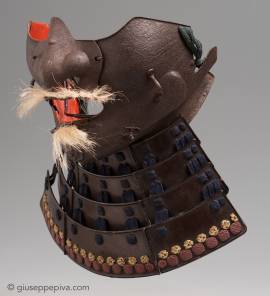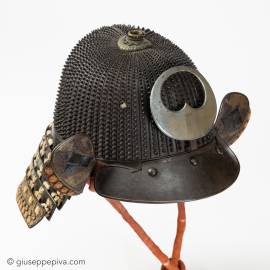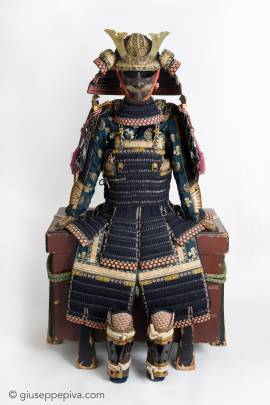Early Edo period, Kaga Myōchin school17th centuryRemovable nose and horsehair application; the surface finished with a file-marks pattern (yasurime).This large menpo shows all the main features of the masks produced in the Kaga area by the various schools of armorers that were active there. The triangular jaw delimited by prominent semicircular embossed parts, the wide oval mouth without teeth and the surface with parallel lines engraved one by one (yasurime) are in fact all recurring elements of the masks produced in this region.We still don’t know how the different Kaga...
WORKS FOR SALE
Early Edo Period, 17th Century A 62-plate koboshi-bachi [helmet bowl with small standing rivets] of typical tenkokuzan form, with 30 pointed rivets on each plate decreasing in size towards the top, with the exception of the larger front plate, with three lines of rivets and the small one on the back which is left blank, for a total of 1,890 rivets.Even if unsigned, the tenkokuzan shape of the bowl (bachi), lower in the center and slightly higher on the back and some other features such as the number and arrangement of rivets, suggest an attribution to...
Samurai armourEdo period (1615-1867), 18th century SignatureThe menpō is signed under the chin 弘前住 明珍紀宗賢 盛吉作 (Hirosaki no Ju Myōchin ki Munekata Moriyoshi saku) CertificateThe armor accompanied by a certificate of registration as Jūyō Bunka Shiryō(Important cultural work)issued by the Nihon Katchu Bugu Kenkyu Hozon Kai (Association for the Research and Preservation of Japanese Helmets and Armor).Literature:Katchu Bugu Juyo Bunka Shiryo Zuroku - Vol. 4, (Tōken shunjû shinbunsha: Tōkyō, 2004), Pag. 76-77Description:The style of the armor is reminiscent of the medieval suits, as common...
Copyright © 2016 - giuseppe piva - VAT: 05104180962










